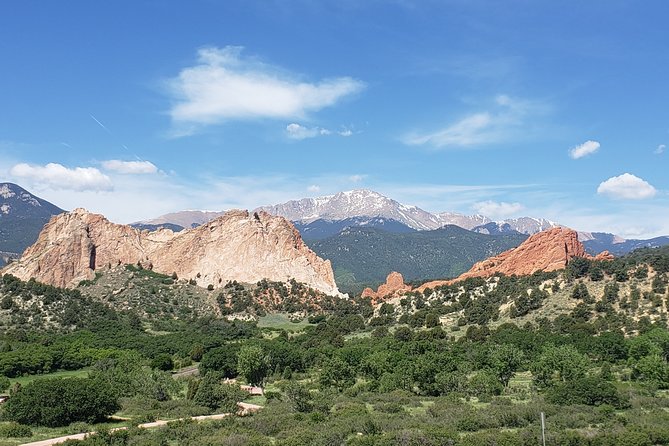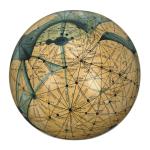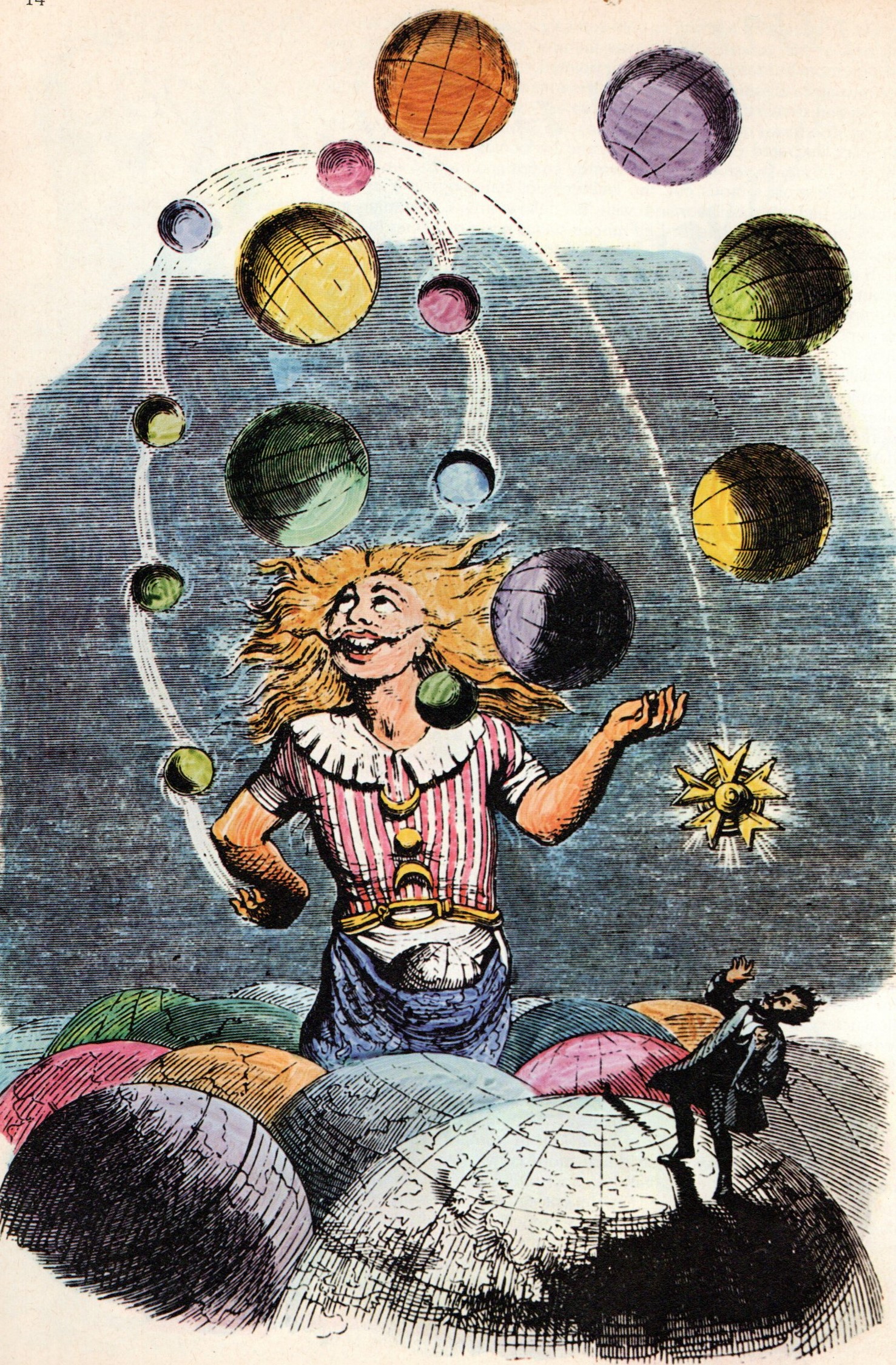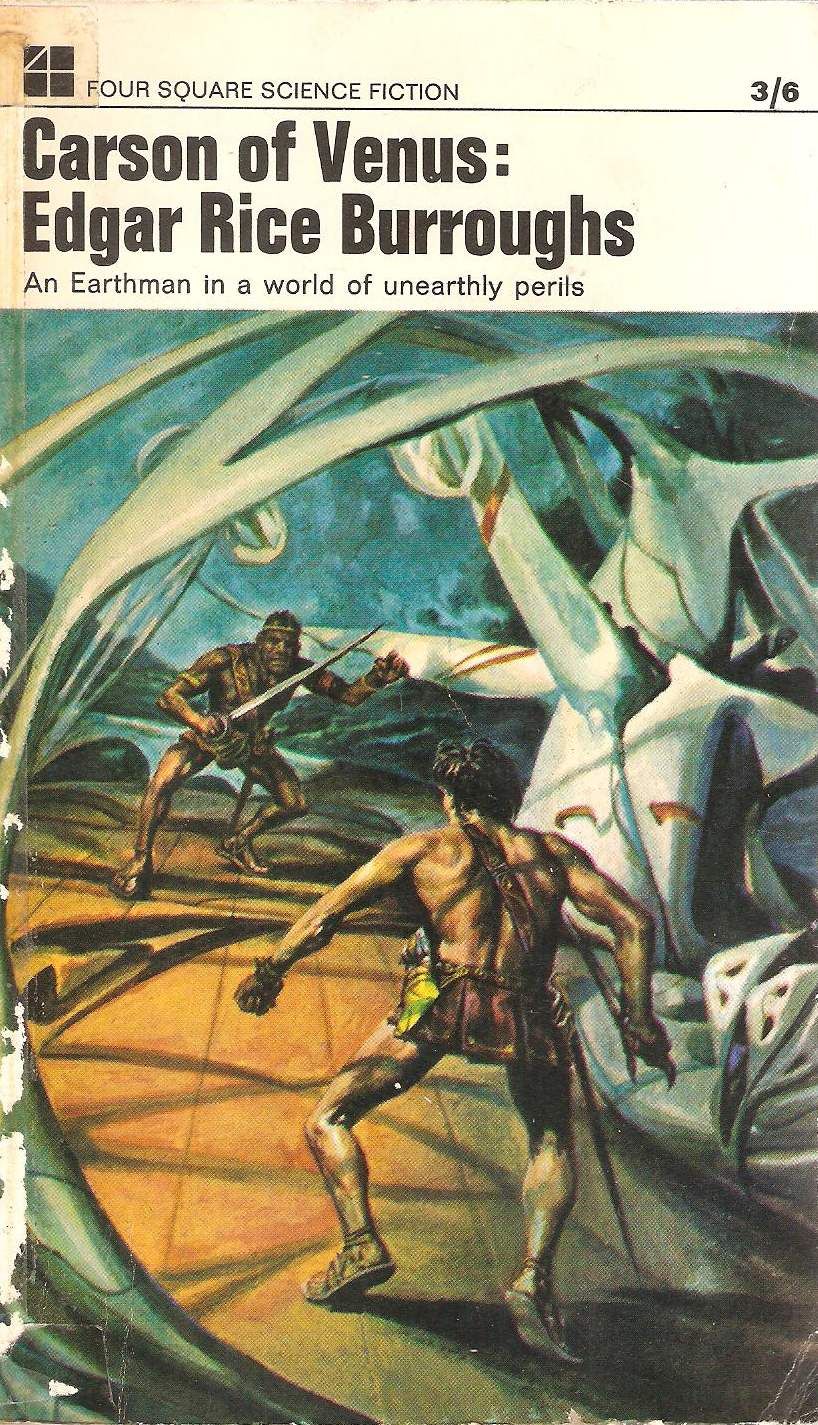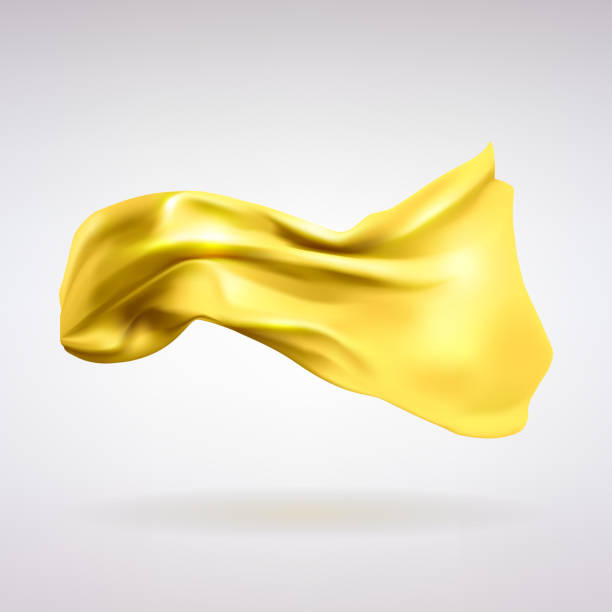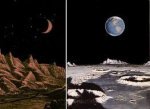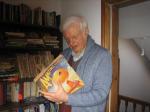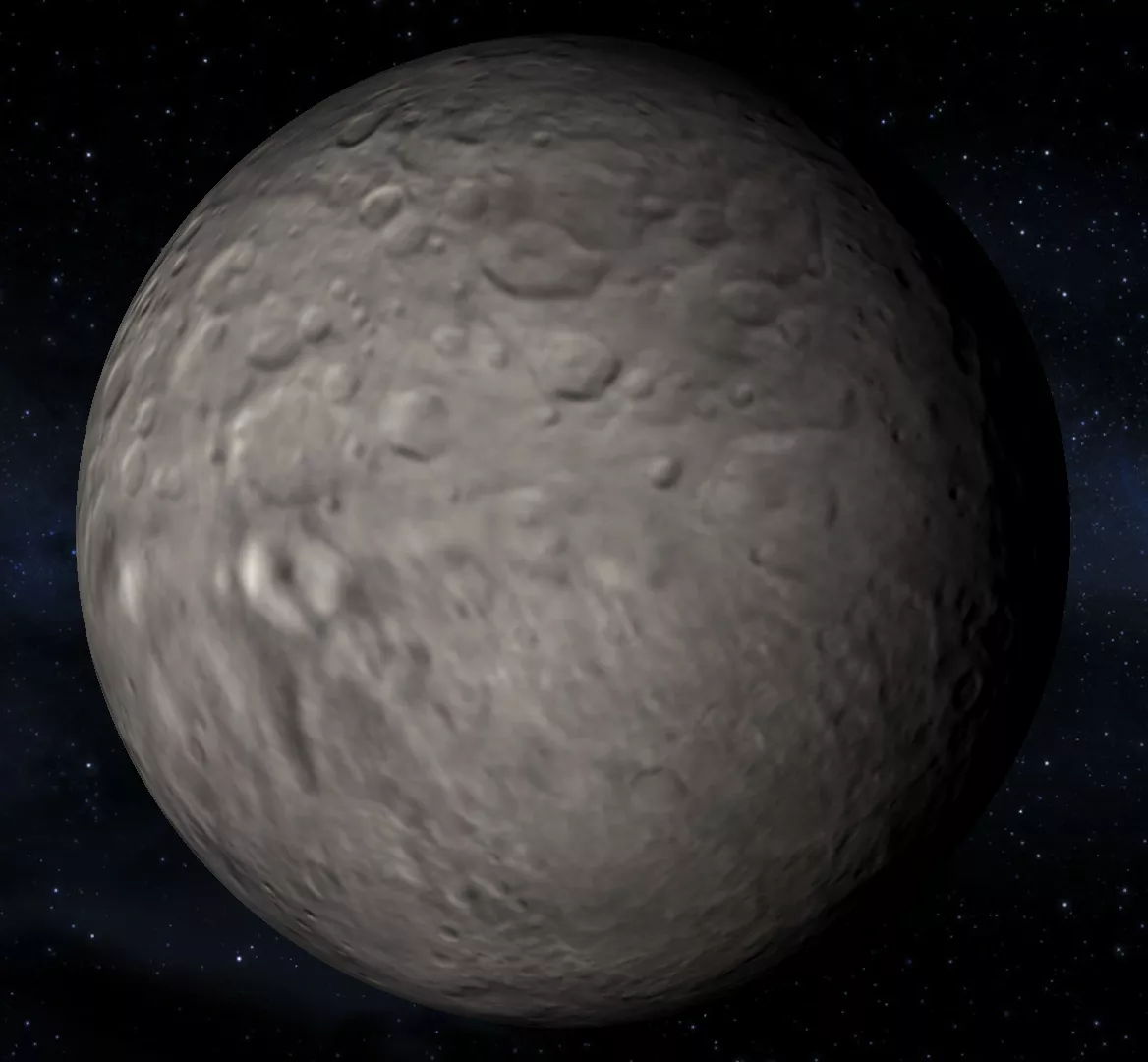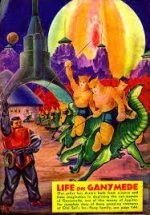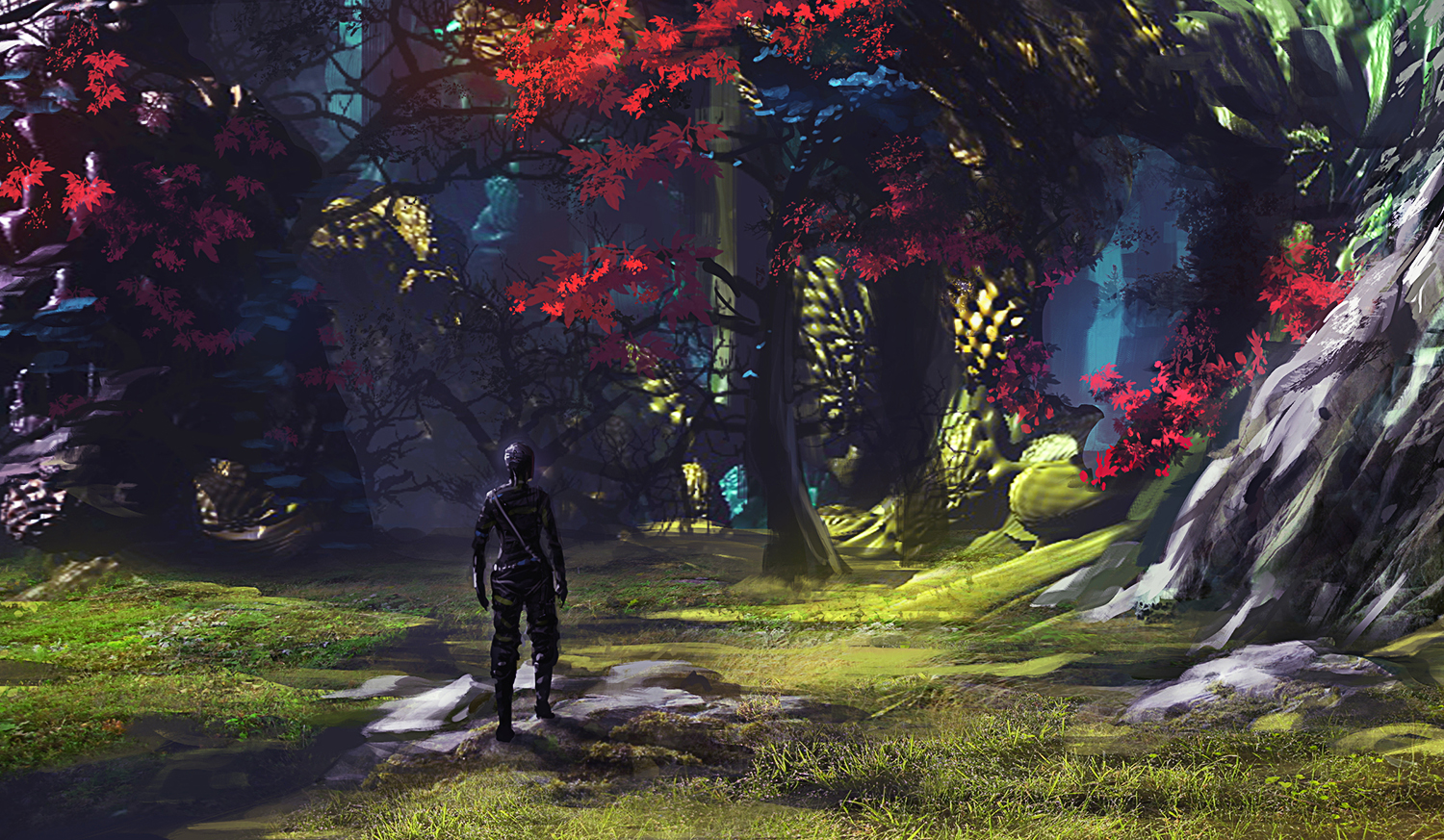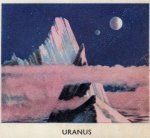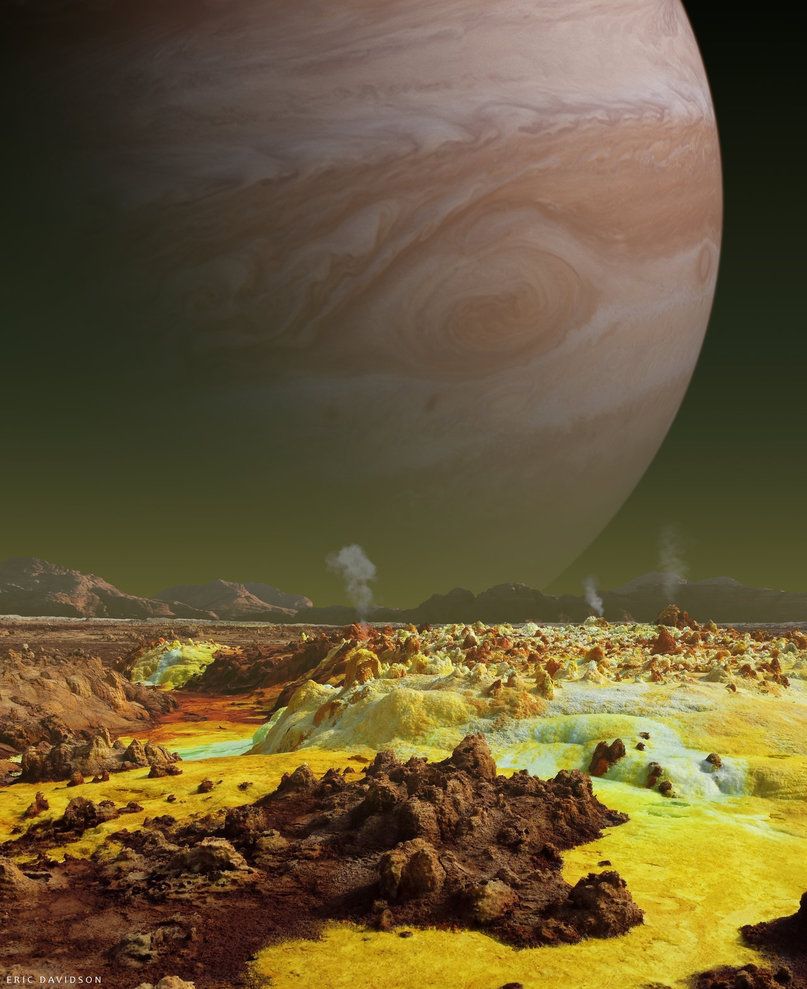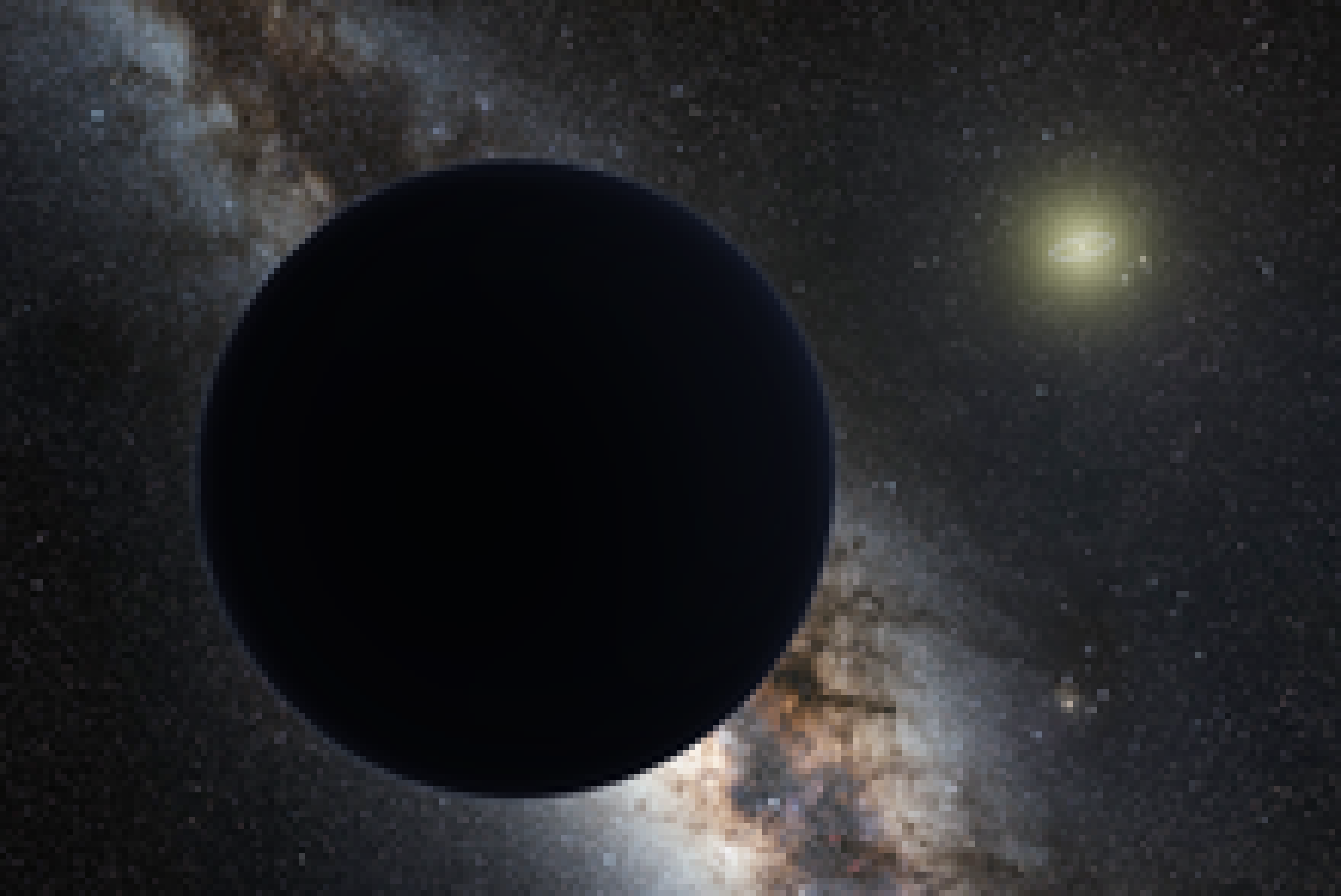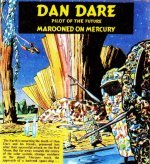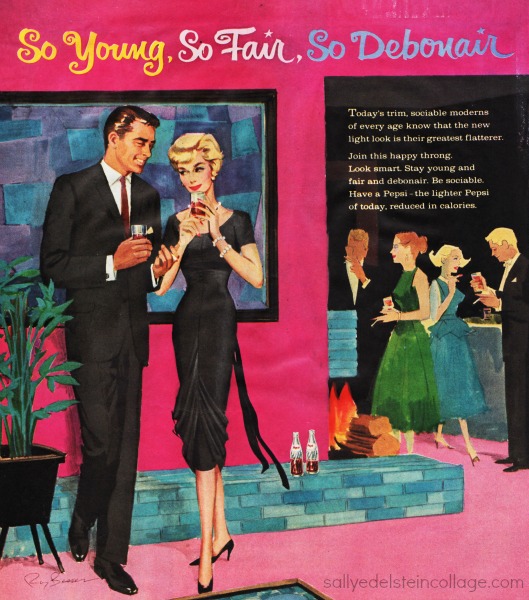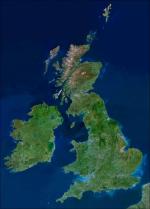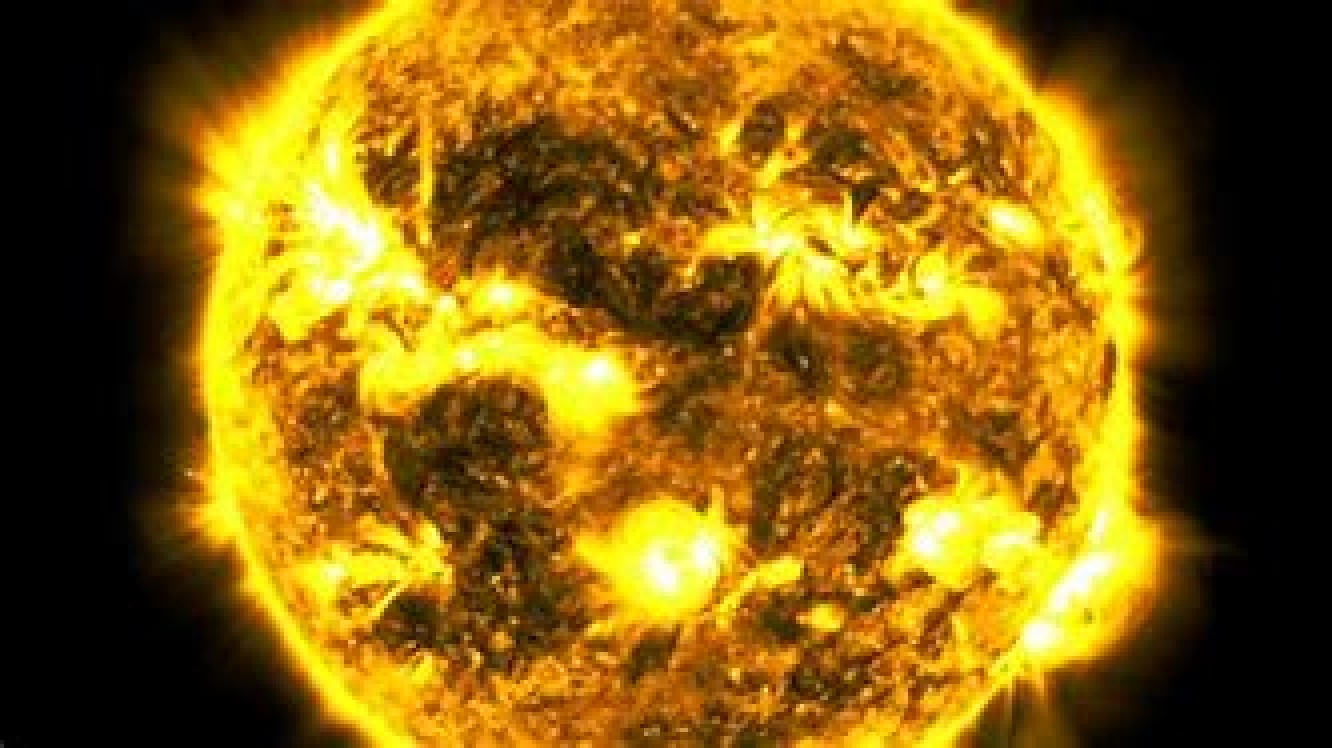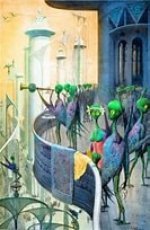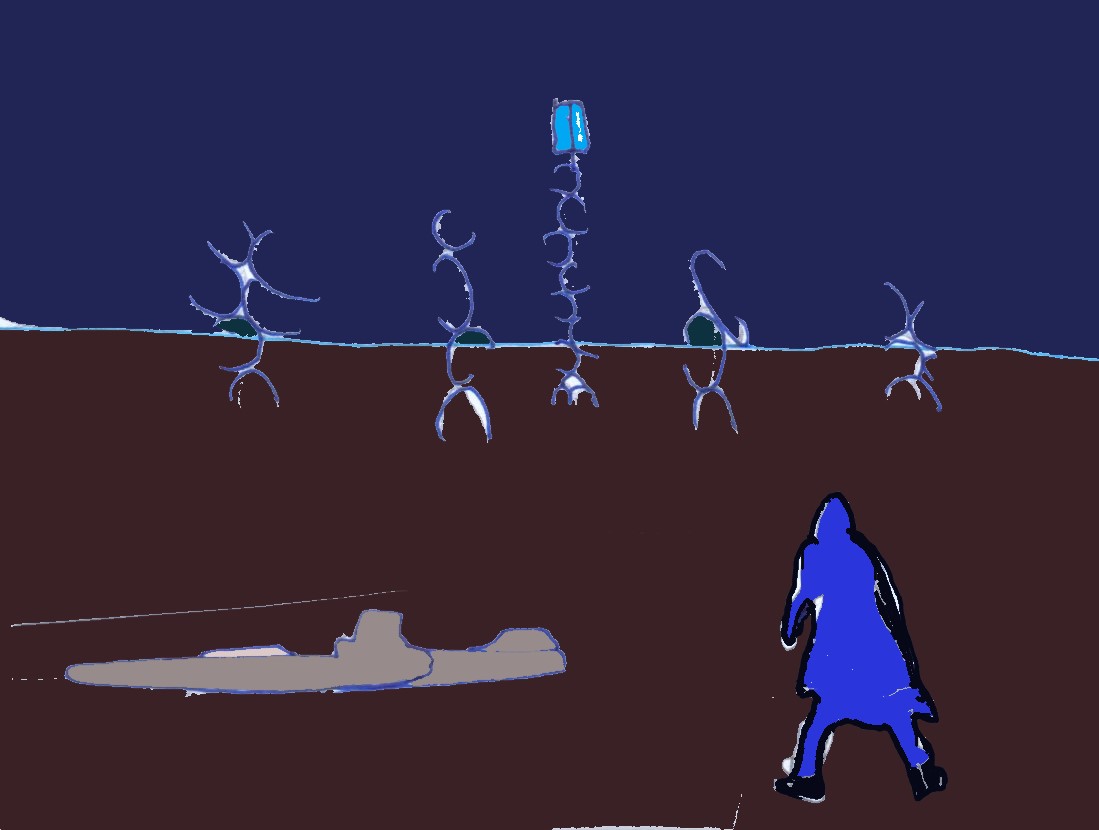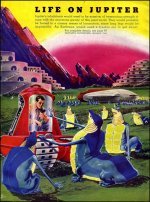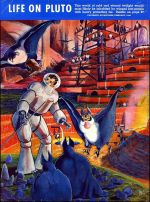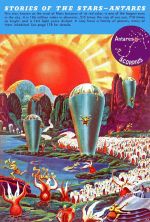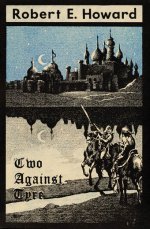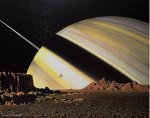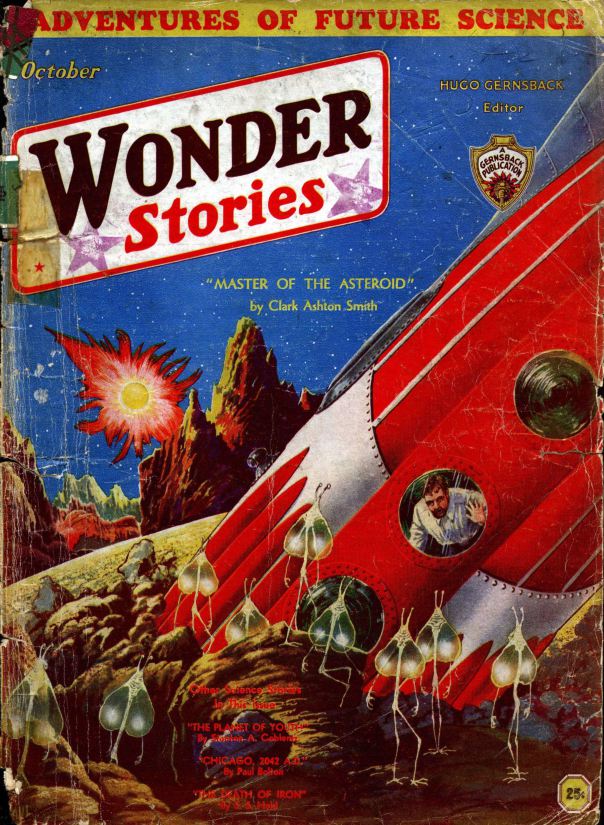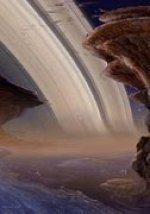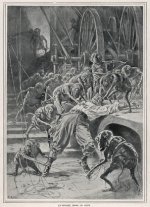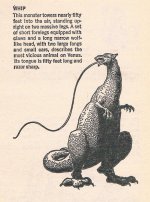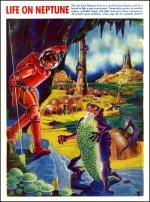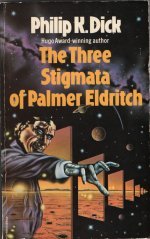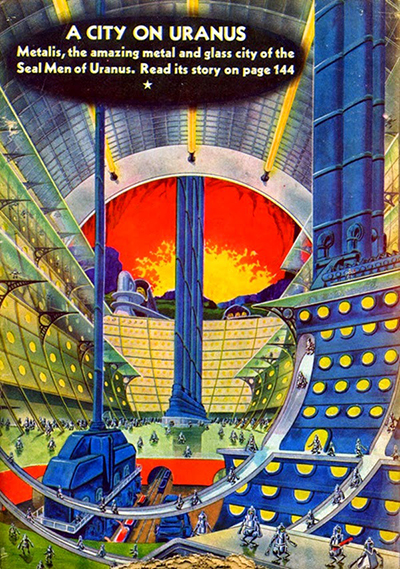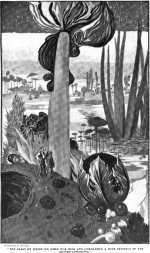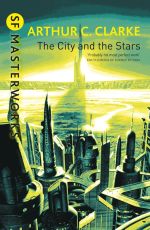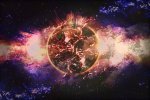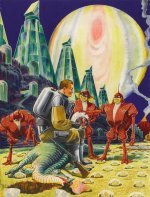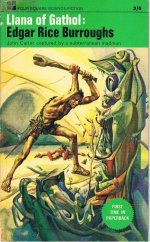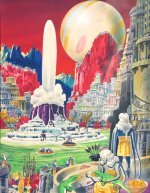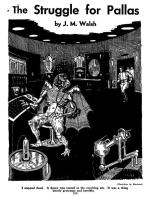what to see on
saturn
For a scenic browse, and an answer-page for Guess The World...
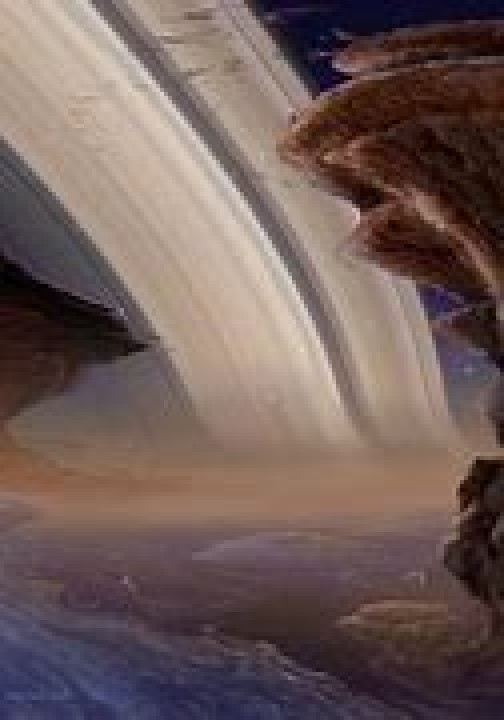
unstable island on saturn
We stepped down onto the island ground, wet and squishy with tiny writhing vermipods.
"I can see why they call it mud."
The goggles were hard to get used to, the freeze-framed images constantly appearing with every lightning flash, lingering and then fading into gaudy shapes of the superimposed temperature patterns. Around us, even protected from the main wind, secondary currents sent sheets of water droplets across the roots, mud, and our suits. In the high atmospheric pressure it felt sluggish to move, not heavy, just thick.
We found tentacle marks on the ground and capillaries rubbed off the vantaroot stems where the tentacles had grasped. The Orska inflate hydrogen sacs along their thorax to move slowly up and down through the three-dimensional landscape like Venusian gorbors or Earthling sloths. But for us to go up, we'd have to climb...
Joel B Jones, Death Songs of Saturn (Vintage Worlds, ed. John Greer and Zendexor, 2018)
elixir-fountain on saturn
...Bright gleamed the lights of the City of Eternal Youth as Curt's small party planed down toward it. Clear through the night rose throbbing music, the sound of laughter and gay shouting.
"The wicked ones make merry at feasting as they do each night," grated one of Curt's winged bearers.
"There is the Fountain of Life," the other told Captain Future. "There are no sinful ones around it at this late hour."
Curt Newton's heart leaped. At last he looked upon the legendary Fountain that he had won to by such toil and hazard!
The City of Eternal Youth had been built around a circular plaza of large size. At the center of that plaza yawned a pit, a deep shaft in the rock, no more than thirty feet in diameter.
Out of that pit ceaselessly spurted a glorious geyser of shining, self-luminous water. Bursting high above the surface of the ground, it kept falling back into the pit, with a dull roaring sound.
This was the Fountain of Life, eternally jetting the Life-water whose insidious poison had been spread by the Life-lord to every world of the System! It gushed from the darkness in hell-born, maleficent beauty, a luring, beckoning thing whose shining loveliness masked unutterable evil....
The
City of Eternal Youth must be the strangest city in all the Solar
System. Its people were all young. Some of them had lived many
life-spans. All these men and women had come here, drawn by the lure of
the Fountain. And they had found that once they drank its waters they
could not depart... This was the City of loud, joyless revelry,
feasting and drunkenness... Their dwellings blazed with lights as they
made merry to forget their inevitable, ghastly fate...
Edmond Hamilton, Galaxy Mission (1940, 1967)
encounter on saturn
...He started down the slope, half-fearing that some of the equivocal objects around him would reach out their mineral boughs or arms to arrest his progress. They seemed to be a kind of bluish-purple obsidian cacti, with limbs that ended in formidable talon-like spines, and heads that were altogether too elaborate for either fruits or blossoms. They did not move as he passed among them; but he heard a faint and singular tinkling with many modulations of tone, that preceded and followed him along the slope. Eibon conceived the uncomfortable notion that they were holding converse with each other; and were perhaps debating what should be done with him or about him.
However, he reached without mishap or hindrance the end of the declivity, where terraces and ledges of decomposing trap, like a mighty stairway of elder aeons, had rimmed the sunken lake of liquescent metal. Wondering as to the way he should now take, Eibon stood irresolute on one of the ledges.
His train of conjecture was broken by a shadow that fell suddenly athwart him and lay like a monstrous blot on the crumbling stone at his feet. He was not prepossessed by the shadow: it was outrageously defiant of all known esthetic standards; and its malformation and distortion were no less than extravagant.
He turned to see what manner of creature had flung the shadow. This being, he perceived, was not easy to classify, with its ludicrously short legs, its exceedingly elongated arms, and its round, sleepy-looking head that was pendulous from a spherical body, as if it were turning a somnambulistic somersault...
Clark Ashton Smith, The Door to Saturn (Strange Tales, January 1932)
hums and gems on saturn
...he got out his sextant, took the altitude of the sun, got cross-bearings and a few angles, and began to make a rough calculation...
"That humming confuses me so that I cannot work correctly," said he, "while the most irrelevant things enter my mind in spite of me, and mix up my figures..."
Changing their course slightly, they went towards a range of hills, in the hope of finding rocky or sandy soil, in order to test the sounds, and ascertain if they would cease or vary.
Having
ascended a few hundred feet, they sat down near some trees to rest, the
musical hum continuing meanwhile unchanged. The ground was strewn with
large coloured crystals, apparently rubies, sapphires, and emeralds,
about the size of hens' eggs, and also large sheets of isinglass.
Picking up one of the latter, Ayrault examined it. Points of light and
shade kept forming on its surface, from which rings radiated like the
circles spreading in all directions from a place in still water at which
a pebble is thrown. He called his companions, and the three examined
it. The isinglass was about ten inches long by eight across, and
contained but few impurities. In addition to the spreading rings,
curious forms were continually taking shape and dissolving...
John Jacob Astor, A Journey in Other Worlds (1894)
condensable saturnian cloud-being
...The cigarette I was smoking fell from my fingers. The extraordinary creature just sat there, clad in Jonah's jacket, looking at the remains of our meal - and claimed unheard-of things!
"You imply that you have no bodies, in the sense that we and your fish and animals have bodies?" I asked.
He slewed his head round towards me, and I met unforgettable eyes.
"We
have highly adaptable, very fluid, body groups," Alpha said coldly.
"You saw the ellipses in which we float; those are the shapes of what
you would call our 'easy' state. Each of us is composed of thousands of
filaments, which we can expand to a haze able to pass through air
invisibly, or contract to a density able to smash rock. For large
operations we form union of hundreds of body groups and carve a
mountain."
>> Donald Suddaby, Prisoners of Saturn
volcanic saturnian shore
...Fleming stumbled on a few yards more.
"If only I could see!" he cried.
As if in answer to his plea, a sheet of rose-colored flame poured from a vent in the side of a mountain nearby, lighting up the region around the ship with a vivid crimson glare. Steam and lava poured from the mountain side, while the ground shook under the force of the blast. Dale and Fleming were hurled to their knees. They made no effort to rise but flattened themselves against the shuddering ground.
To
his horror Dale perceived that the ship had landed upon a narrow ledge
projecting along the edge of a sheer wall of ice. Peering cautiously
over the side he gazed a thousand feet down into a sea tossing under the
shock of the eruption. Sick and dizzy, he crept back to the sheltering
wall of the cliff. The flame subsided...
Philip Latham, Missing Men of Saturn (1953)
sinister saturnian shrubs
…The desert valley floor behind them seemed suddenly to have sprouted some tall bushes. There were possibly a dozen of them standing at intervals of twenty yards. They were too far away – perhaps one eighth of a mile – for Dynamon to see them very well, but they appeared to consist of a score of leafless branches radiating outward in all directions from a small core. It was as if a basket ball was bristling with ten-foot javelins.
“Where did they come from?” Dynamon gasped. “I didn’t see them when we walked over that ground a few minutes ago.”
“Nor I,” agreed Thamon. “I can’t imagine where they came from.”
Just then one of the bushes apparently moved a few feet as if blown by the wind.
“Good lord!” exclaimed Thamon. “Did you see that? One of those things rolled forward!”
Then another of the fantastic bushes started to roll, and another, and another. In a moment all twelve of the extraordinary apparitions were rolling rapidly down the wind toward the humans. Dynamon felt the hair on the back of his neck stiffen…
- John Wiggin, Cave-Dwellers of Saturn (Planet Stories, Winter 1939)
the contemplatives in the sphere of saturn
Dentro al cristallo che 'l vocabol porta [Within the crystal which bears the
name,
cerchiando il mondo, del suo chiaro duce circling the world, of its famous
chief
sotto cui giacque ogni malizia morta, under whom all wickedness lay
dead,
di color d'oro in che raggio traluce of the colour of gold in which rays
flash
vid' io uno scaleo eretto in suso I saw a ladder reaching up
tanto, che nol seguiva la mia luce. so far, that my sight could not
follow it.
Vidi anche per li gradi scender giuso I also saw, descending by the
steps,
tanti splendor, ch' io pensai ch'ogni lume so many splendours that I
thought every light
che par nel ciel quindi fosse diffuso. that appears in heaven had
been poured out there.]
Dante Alighieri, Paradiso (1321) - Canto XXI, lines 25-33
insectivorous saturnian kite
The creature was insectivorous. During each of the periodical winds, it allowed itself to be swooped into the air, maintaining contact with the ground by spinning its lengthy filament. One end of the threat was firmly attached to a rock by some organic adhesive manufactured within its glands. In the teeth of a gale, it spread itself wide imitating a parachute net, to trap the millions of insects being dashed about by the wind. At any time, the kite could descend by "reeling in" on the practically indestructible strand.
"I'm glad we managed to catch a couple of those things," Gerry remarked. "I have an idea we might make a fortune from them."
"No kidding! How? Sell 'em to little boys every March?"
"No,
silly. Get a couple of those creatures to spin a few miles of that
amazing filament, and you could weave a coat or any other garment that
would never wear out. Just think what the cotton and wool and silk
tycoons would pay us to keep that off the market!"
Arthur K Barnes, Interplanetary Huntress (1956)
liliputian men of the grasslands of saturn
…In the far distance, a few hundred miles off, loomed the hazy outlines of trapezoidal mountains. Apart from them, the scene was one of grass, grass, grass, interspersed every few miles by a dense hunk of taller, darker vegetation…
…He remembered he had landed deliberately at the border of the brighter patch of grass. Well, before he left, he could at least walk over and have a look at that slightly different area…
…he stopped for a while and listened to the ringing silence around him. It was extremely important for him, just then, to look back and reassure himself that Jumbo was where he had left it, and that no other additions to the landscape had appeared within his 360-degree field of view.
For now he strongly suspected that he had come upon a secret.
The realm of brighter grass was inhabited.
Semi-transparent humanoids, multitudes of them, six inches high, swarmed almost weightlessly over the grass-blades, hardly depressing them as they leaped from one to another. Their bodies were a very light blue, but they looked quite human.
They were leaping all the more urgently because they had seen him. Suddenly the edge of the bright area bristled with what looked to him like little pop-guns, made of stuff that looked solider than the folk who had constructed them…
Robert Gibson, The Arc of Iapetus (Vintage Worlds 3, ed. J M Greer and Zendexor, 2020)
>> Guess The World - Third Series
swimmers in the air of saturn
From what they could see of the surface of Saturn it seemed to be a dead level, greyish brown in colour, and not divided into oceans and continents. In fact there were no signs whatever of water within range of their telescopes. There was nothing that looked like cities, or any human habitations, but the ground, as they got nearer to it, seemed to be covered with a very dense vegetable growth, not unlike gigantic forms of seaweed, and of somewhat the same colour. In fact, as Zadie remarked, the surface of Saturn was not at all unlike what the floors of the ocean of the Earth might be if they were laid bare.
It was evident that the life of this portion of Saturn was not what, for want of a more exact word, might be called terrestrial. Its inhabitants, however they were constituted, floated about in the depths of this semi-gaseous ocean as the denizens of earthly seas did in the terrestrial oceans. Already their telescopes enabled them to make out enormous moving shapes, black and grey-brown and pale red, swimming about, evidently by their own volition, rising and falling and often sinking down on to the gigantic vegetation which covered the surface, possibly for the purpose of feeding.
George Griffith, A Honeymoon in Space (1901)
>> Guess The World - Third Series
jet-powered inhabitants of saturn
Petra finished her climb with the rest of the flock. They had risen far into the sky during the long climb upward in the darkness. Bright was rising in the east and its warming light was streaming down through a break in the cloud layers above. That didn’t happen very often and the flock circled in the beam of light, enjoying the warmth, singing gossip back and forth to each other. Petra could feel Petru’s air sacs expand in the warmth. With the additional buoyancy of Petru’s body, she could gain even more altitude for Petro, so she had Petru swallow another mouthful of bitterly cold rarefied air, and tilting the wings upward, she jetted Petru higher into the sky, the rest of the flock following along behind, maws opening and closing to feed the pulsing jets that drove them ever higher. As Petru climbed, Petra raised her head and gazed upward at Bright. Petra’s large eye could see the flock of smaller lights that circled around the distant glowing sphere of warmth. She could easily see the larger red globe, Rexu, and the smaller red globe, Talu, that circled Bright at great distances. She knew there were three other globes close to Bright, but usually they were so close they could not be seen through the glare. She raised a claw in front of her eye to block out the light from Bright and was rewarded for the effort by being able to observe two small bright spots close together – a larger blue-white light and a smaller gray light. It was Parent-and-Child. They must be at their farthest excursion from Bright, since the two globes were well separated from the glaring orb and were in their half-moon phase.
Petra knew that Rexu, Talu, Parent-and-Child, and the others must be globes, like the world Air that she lived on. Ancient long-dead elders of the flock had determined many dimmings ago that Air was a globe by reasoning its shape from the shadow Air cast on the rings of Arc. There was even a tale passed from flock to flock of one ancient and reckless young ruus that had left its flock flying east and had managed to fly all around Air, returning to the flock from the west, proving Air was round…
Robert L Forward, Saturn Rukh (1997)
>> Guess The World - Fourth Series
terran captives brought to a city on saturn
THE journey across the gloomy windswept plain seemed interminable. Rocks, scrub vegetation of a bizarre, alien variety, occasional patches of snow... the earthmen, pale automatons, the huge Saturnians moving, quite unconsciously it seemed, in time to the roaring, ragged rhythm.
An hour's walking brought them to the city. In the center of a plain almost Mars-like with its red iron rust, a cluster of massive spires and towers thrust at the grey sky. Domes, bridges, ramps made an intricate filigree of stone, grim, solid, age-old. Sweeping like some huge mercury arc above the city was a curved tube of immense proportions, its ends disappearing into the ground on each side. The tube glowed whitely, giving off light and, apparently heat. Molten lava from the planet's core, Chance decided, run above the city to warm it, then forced below to be reheated. He eyed their tall furry captors with new respect. He had fancied them primitive, backward...
The interior of the city was another revelation. It seemed built entirely of a soft yielding material, very tough, not unlike a hard rubber. Walls, streets, buildings, all were of this plastic, deadening footfalls, echoes. Except for the eternal sourceless rhythm, the city was like a tomb. Not a sound from the crowds of Saturnians who lined the streets, though the air was full of thoughts... blurred, incomprehensible thoughts that brought no clear pictures to the earthmen's minds...
Frederic Arnold Kummer, Jr., Slaves of Rhythm (Amazing Stories, January 1940)
>> Guess The World - Fourth Series
Note from contributor Lone Wolf:
A story set on a solid surface Saturn. The
principal idea, that the Saturn's rings generate some particular waves, which
affect the psyche and change people, is similar to that in Harl Vincent's story
"Creatures of Vibration" (1932). Maybe it was inspired by it or such
notion simply was popular in the SF of that time and there could be other
stories like these, but so far I haven't found another.
attacked in a fungus forest on saturn
The great fungus forest that covered much of Saturn stretched about them in the cold mist, illuminated by the combined ring-light and moonlight. All around the little clearing in which they stood towered the enormous fungi, huge gray growths in the form of bulbous spheres, drawing their sustenance by parasitism from the thick mat of spongy mosses underfoot.
Nothing appeared stirring except a few “diggers"—furry little beasts with flat, spade-like noses, whose red eyes fearfully watched from tunnel-mouths nearby. The only sounds were the occasional zooming drone of pinkly luminous “fire bats” winging through the towering fungi, and the long, distant ululation of a pack of “climbers."
The sky over the Planeteers’ heads was weirdly magnificent— dominated by the colossal arc of the rings that spanned the heavens just south of the zenith like a huge, shining, white rainbow. Out beyond the rings shone the bright shield of Titan, sinking rapidly toward the horizon while Tethys and Rhea rose like twin jewels among the stars.
"I don't hear anything,” muttered Sual Av finally. “But the noise of the ship landing may have attracted—"
"John, look out!” yelled Gunner Welk suddenly. “A slith!"
One of the smaller bulbous gray fungi of the forest had suddenly begun to move. It came toward them with rocket-speed, a charge almost faster than the eye could follow.
Thorn knew it was slith as he flung his atom-gun to his shoulder. That creature alone could so perfectly mimic the gray fungi by means of its protective coloration, Thorn glimpsed the charging thing over the sights of his weapon for an instant, a bulbous, oily gray monster ten feet high, its dumpy, shapeless body running with incredible swiftness on thick little legs, the two cold, bright eyes in the front of its faceless body flaming as its white-fanged mouth gaped unbelievably wide.
He fired and missed. His shell exploded blindingly just behind the charging slith. Gunner fired an instant later, and his atom-shell hit the creature's side. When the flare of the shell vanished, they saw the great gray mass lying unstirring only a dozen feet from them.
Edmond Hamilton, The Three Planeteers (Startling Stories, January 1940)
>> Guess The World - Fourth Series
Comment from contributor Lone Wolf:
This story presents one more version of the OSS by Edmond Hamilton. It seems to be in the same universe as that of Doom Over Venus, published a month later in Thrilling Wonder Stories. Both stories are said to happen about a thousand years after the first space flights (in The Three Planeteers the year is 2956) and the nine planets are inhabited by descendants of colonists from Earth, from which the different planetary races have developed. Still, there are also green native Venusians, mentioned in Doom Over Venus, and Sual Av, one of the Planeteers, seems to belong to them, although this is not explicitly stated - he is described as green-skinned with frog-like face, while at the same time there is mentioning of "white Venusian girls" in the text. Another common element is a jumping one-legged creature - the "uniped from Io", which appears incidentally in both stories. Some other elements from The Three Planeteers have been re-used by Hamilton later in his novels from the Captain Future series, like for instance the "space dog" Ool from Ceres - a vacuum-living silicon-based telepathic creature - which is clearly the prototype of Eek the "moon pup"; also the space pirate song ("From Mercury to Pluto, from Saturn back to Mars...") is quoted literally in one of the Captain Future novels, only without the last line, which mentions the pirate asteroid Turkoon. But the fictional chronology and history of the space exploration is different: here the first space flight is made by Robert Roth in 1996 - he visits Mars and Venus, and in 2000 makes the second flight to Jupiter and Saturn, but crashes in his return to Earth. Then his chief aide Clymer Nyson visits Uranus, Neptune and Pluto, but later disappears in attempt to reach the tenth planet called Erebus (as it turns out in the end, he actually landed there in 2006). By 2085 the first permanent colonies are established on Mars and Venus. By 2150 all the planets from Mercury to Neptune have been colonized, in 2470 starts the first independence movement and by two centuries later all colonized planets have become independent worlds. Thus in the 30th century, when these two stories are set, there is still no interstellar flight. This differs both from the chronology of the Futurian universe and that of the so-called "200,000 years" of future history from the other Hamilton books. It would be interesting if he's written some other stories, set in this same universe, but so far I have found only these two...
Also I've seen suggested by fans that The Three Planeteers is like a Hamilton's space version of The Three Musketeers, but save for the similarity of the titles I personally don't see any resemblance of plot or characters. In fact the Futuremen from his Captain Future series fit much more closely to the character archetypes of the musketeers, although I cannot say whether they have been indeed inspired by them.
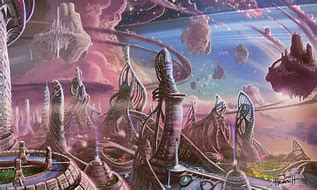 by Jon Hrubesch
by Jon Hrubesch